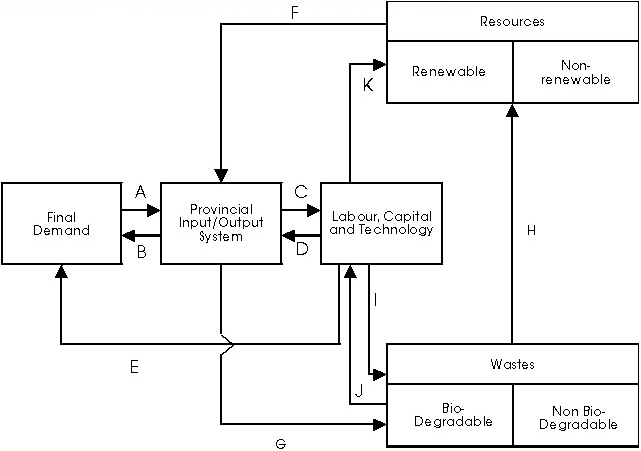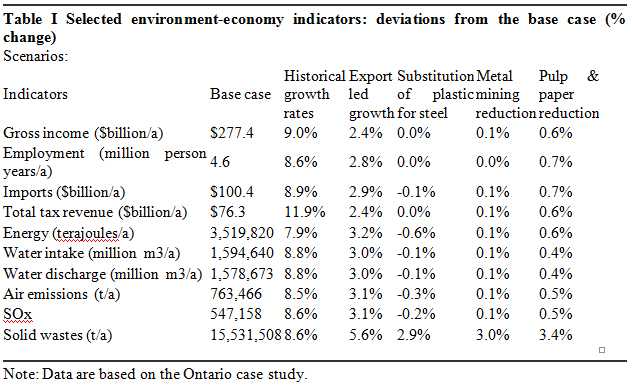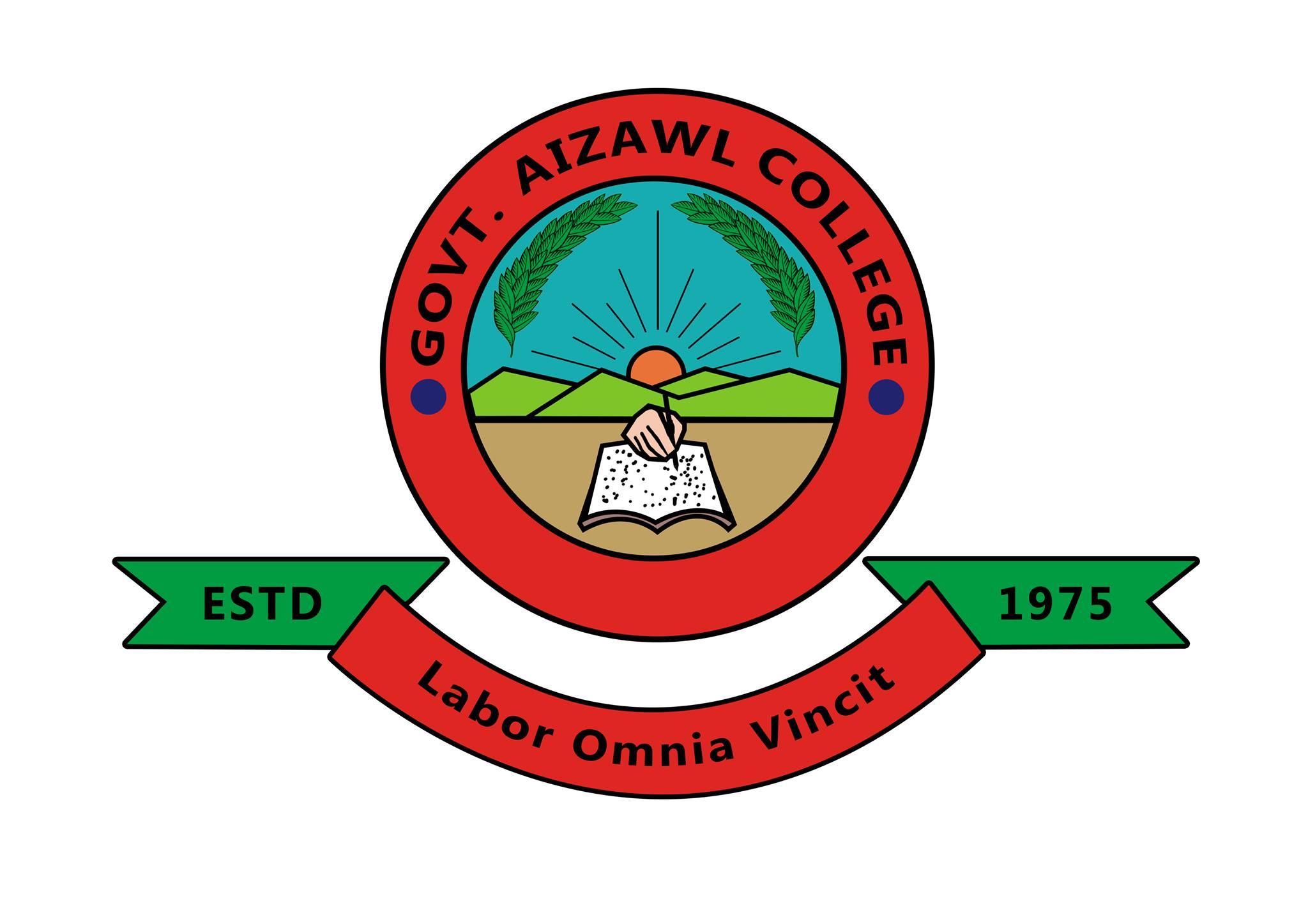Modeling environment-economy relationships
An IndEco project report An impetus has arisen to develop models to integrate human activities with environmental systems from questions about the economy, the environment and sustainable development asked by government, industry and the public. The answers to these questions require new tools of analysis. A model of environment-economy linkages is such a tool, useful for policy research and development focused on sustainability.
The following discussion presents one possible framework for describing economy-environment linkages. A case study of the model's application to the Province of Ontario is also presented.
A theoretical basis for examining environment-economy linkages
The underlying concept for the development of an environment-economy model is the recognition that all economic activity requires materials and energy drawn directly and indirectly from the environment and, that ultimately, these materials and energy are returned to the environment as waste products. The economy consists of the activities commonly referred to as production, distribution and consumption undertaken by humans. Not only is the economy a sub-system of the ecosphere; it is also a sub-system of the larger set of activities that make up social life. It is within this dependent relationship (i.e. of the economy operating within the environment) that the concept of sustainable development--the requirement that current practices should not diminish the possibility of maintaining or improving living standards in the future--is examined.
Such a materials/energy balance perspective of the economy differs markedly from the more conventional view of the economy which focuses on the circular flow of income and the exchange of commodities in markets, and ignores linkages to the environment (i.e. the economy is a closed circuit model with households supplying the factors of production (land, labour, capital and entrepreneurship) to firms that produce the output and distribute income to households). Application of the approach has been undertaken in various countries and regions.
In this context, sustainable development requires that economies operate within limits. The market system continues to function but it must be obliged to do so within constraints imposed by government to avoid the uncertain consequences that nature will ultimately impose.
A framework for an environment-economy model
From a modelling perspective, the concept of limits to human activities (i.e. to achieve sustainability) can be introduced through a set of constraints expressed mathematically. More problematic is: i) the selection of the variables that should be constrained to capture the meaning of sustainable development; ii) the measurement of such variables; and iii) the process to establish appropriate constraint values. The challenge is to specify a set of constraints that are comprehensive and measurable without becoming too detailed.
Figure I (below) provides a schematic representation of the conceptual framework for the model. The economy, which consists of the provincial input/output macro system, final demand and labour, capital and technology, is shown by the three boxes on the left. The economy uses the environment for inputs to production and as a receptacle for its wastes. In addition, the quality and quantity of the resources available to the economy is affected by wastes placed in the environment. Thus, the environment supports the economy by supplying resources and accepting wastes, two functions which themselves are interrelated.
A spatially disaggregated input/output model includes linkages A, B, C and D and can deal with exogenous demands for capital equipment (i.e. link E). The challenge in the development of an environment-economy model is to incorporate the other linkages into the framework.
An environment-economy model
An environment-economy model conceived from the framework described above was developed using an extended conventional input/output framework. The modelling effort focused on the definition and mathematical formulation of linkage E (to make capital expenditures endogenous i.e. including final demand sectors as a part of production), and F and G (to make explicit the flows to and from the natural environment). An adjustment to conventional I/O models was also made to identify the scope and level of activities arising from environmental industries in the economy, illuminating the prominent role of this sector in providing waste management services and pollution control products and processes.
Linkages H, I, J and K were not included in the model framework since the disaggregated site specific data required to include these linkages are currently not available. The exclusion of these linkages resulted in a comparative static modelling system (i.e. a system which compares equilibrium states of the environment-economy relationship). The resulting model permits different choices of final demand, technological processes and regional locations. The model is closed by incorporating consumption and import demand equations that relate these variables to disposable income in the case of consumption and total income in the case of imports.

Figure 1 Conceptual framework of the environment-economy linkages model
The model allows for different growth rates to be stipulated to scale the different components of exogenous final demand categories. It is also possible to investigate the economic impact of level and compositional changes in the economy. Since environmental impacts are related by fixed technological coefficients to the various levels of output and employment, economic and environmental impacts are determined simultaneously. In addition, all the environmental coefficients in the model can be adjusted or updated. The database provides default values. As knowledge improves both the economic and environmental databases can be revised. This modelling flexibility is important as changes in policy are likely to increase the efficiency of the economic and environmental processes (i.e. lower emissions per unit of output).
By changing the geographical resolution of the databases, the model can also be adjusted to operate on the basis of watersheds instead of jurisdictional boundaries. This requires that all data are geographically referenced at a suitable level of spatial resolution.
The economic impact of macroeconomic trends is reported in terms of a number of indicators. These include: sales (shipments of products and services), gross income, taxes by type of tax and the level of government collecting the tax, employment in total and by 25 major industrial groups. Environmental impacts are presented in terms of a number of indicators which include emissions (SOx, NOx and VOCs); water consumption and discharge; energy by five types of fuels in physical and energy units (crude oil, hydro, natural gas, coal, nuclear, and liquid petroleum) and solid waste by 19 types. These impacts are shown by industrial activity and can be presented spatially.
These impacts are sensitive to the technological choices made by society. Traditionally, input/output analysis relies on fixed technological coefficients and constant returns to scale. However, in the case of paper production, an alternate recycling technology is available. The model allows for this technological choice.
An application of the model
A case study to assess the applicability of the model was undertaken for the Province of Ontario. The purpose of the case study was to assess the model's ability to identify, and assess the implications of, different economic and environmental policy scenarios.
For the case study, a set of hypothetical policy developments are developed effecting Ontario's economy and environment. These scenarios are not predictions or forecasts. They are a systematic analysis of a set of assumptions whose consequences are quantified using the model. None of the scenarios should be construed to represent an actual case or likely future.
Base case scenario: developed to derive the employment, gross provincial income, taxes and environmental impacts in 1990 using the actual final demand data (i.e., investment in machinery and construction, government expenditures and exports, etc.). All of the other scenarios are constructed from the base case scenario.
Scenario 1 historical growth rates: the historical growth rates of sectoral output in Ontario between 1981 and 1989 as the basis for projecting output between 1989 and 1990. In other words, this scenario examines the implications of the economy continuing to grow between 1989 and 1990 at the same rates of growth as those observed between 1981 and 1989.
Scenario 2 export led growth: duplicates the base case with the addition of a 5% growth in exports. All other exogenous variables remain unchanged from their base case values. This scenario simulates a result of increased free trade and the declining value of the Canadian dollar against the U.S. dollar. It is also interesting as a gauge of the impact on the economy and the environment of a lopsided recovery with exports playing the major propulsive force in the economy.
Scenario 3 - substitution of plastic for steel: the economy continues to experience shifts in the use of inputs prompted by economic and environmental considerations. Plastic is increasingly replacing steel and aluminum in the making of containers. In this scenario an attempt is made to model the dynamic consequences on the economy and the environment of an aggressive plan to substitute plastic for steel.
Scenario 4 - contaminant reduction in the pulp and paper industry: the discharge of contaminants is industry specific. Programs to reduce conventional, non-conventional and metal contaminants involve capital expenditures and operating expenses. The magnitudes and effectiveness of these programs are also industry specific. In this scenario a spending on equipment and other environmental products and services is simulated to effect a reduction in ammonia discharges, total phosphorus, and TSS from pulp and paper mills.
Scenario 5 - contaminants reduction in metal mining: the same as Scenario 4 except spending on equipment and other environmental products and services is simulated to effect a reduction in TSS, total cyanide, copper, lead and zinc discharges from metal mining operations.
Table I(below) presents the scenario results as percentages relative to the base case. The results provide an initial appreciation of the type of outputs available from the model. The environmental results presented are more varied and detailed and include: water intake and discharge, emissions by three types, energy by five different fuels, solid waste by 19 different types and wastewater contaminants by nine contaminants. The model also differentiates outputs and differentiates outputs by industry and region (county).
Conclusions
The environment-economy framework and model described above is an attempt to integrate the environment within a macroeconomic framework. The fundamental strength of the model is its ability to establish quantitative links between economic activity and the environment within a general framework. This includes both conventional economic impacts and the impacts of a chosen path of economic activity on the environment--indicating the sustainability of the activity.
Equally important, to the discussion of sustainable development, is the ability of the model to project the likely economic and environmental impacts of a given configuration of the economy into the future. Since final demand components in 1990 drive the model developed here, it is possible to gauge the sensitivity of the economy to environmental constraints or the environmental impacts of different economic performance levels. Moreover, the model's flexibility allows changes to be made to these final demand components, as well as changes to the environmental coefficients and stock of natural resources embodied in the model. This permits the testing of the sensitivity of the system to different economic or regulatory schemes that aim at changing the pattern of environmental activities.



















